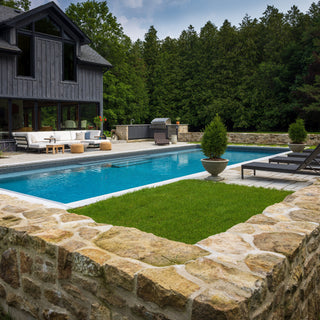
Guides & Tips
Resilient by Design
Crafting Outdoor Kitchens for the Highland Climate. Unpacking sunlight, snow, and the soul of mountain living.
By Renee Soucy
Carving its way up the high plateaus of New Mexico and Colorado to the alpine valleys of Wyoming, Montana, and Idaho, and farther northward through the Canadian Rockies and interior British Columbia, the Highland Climate invites awe while defying expectation. With many elevations above 5,000 feet, it is a landscape of endurance, where design professionals must balance beauty with hardiness.
Lifelong mountain enthusiast Scott McHale brings nearly three decades of experience to his role as Principal & Director of Design at Z Group Architecture & Interior Design, a practice that was founded over 70 years ago in Aspen, Colorado with a design philosophy that honors nature and wildness through design that reflects the “same elements as the mountains which frame the valley.” In a career spanning resort, residential, and civic projects in an environment that leaves its mark on almost every surface, a deep understanding of the climate’s rigors and rewards has become a hallmark of Scott’s work.
Design That Waits Well
At high elevations, where the seasons are as vivid as they are unyielding, McHale approaches outdoor spaces as reflections of their surroundings: an environment that comes alive in brilliant bursts of activity and rests through long intervals of stillness. “We work in a high-altitude, cold-winter resort climate where the sun and temperatures are wildly varied and intense,” he explains. “Most projects are second homes, so these properties are sitting idle most of the year, then used when clients are in town.”
In the Highland Climate, smart design is as much about readiness and resilience as it is aesthetics. Outdoor spaces need to feel inviting when homeowners return, yet sturdy enough to withstand months of snow, wind, and high-altitude sun. Some might think of outdoor kitchens as a warm-weather indulgence but – when well-executed – they can reflect the resilience and performance the climate demands. With thoughtful planning, an outdoor space can feel as effortless in July as it does durable in January.
For McHale, every project begins with a story and collaboration begins with conversation. “We explore how clients want to live outdoors, what protection is needed, and how it [the space] should feel,” he says. Creating balance between pleasure and practicality comes from achieving an essential understanding of how the occupants will move through space, how light falls at certain hours, and how comfort shifts with wind or shade.
This knowledge is especially critical in a climate where many seasonal homes sit vacant for months. A well-considered design will include systems that anticipate that absence—shut-off valves, effective drainage, resilient covers, and materials that can handle the elements. Whether basking in sunlight or blanketed in snow, the space should welcome without effort, endure without excessive supervision, and always feel at one with its surroundings.

Image Credit: Studio 27 and Dallas & Harris Photography
UV – The Invisible Element
At high altitude, even sunlight will carve, bleach, and burnish everything it touches. Like so much of the built environment, it comes down to physics: thinner air contains less moisture and fewer particulates, allowing ultraviolet radiation to strike surfaces with far greater force. Each thousand feet of elevation adds roughly 10 percent more UV exposure, so materials weather faster, colors shift sooner, and unprotected finishes quickly lose their depth.
In alpine environments the light is sharper, the UV stronger, and the swings between morning chill and afternoon heat are also significant. Materials expand, contract, and fade much faster than many would expect, requiring finishes that can live with the intensity rather than fight it. Considered choices, balancing the natural with the manmade, lend mountain architecture its enduring, soulful character. In the Highland Climate, the same conditions that push materials to their limits are the ones that can ultimately reveal their true beauty.

“What I enjoy the most about designing in the Highlands is the setting itself.
You get great outdoor spaces with these amazing views, lots of sunshine and fewer bugs, so being outside feels wonderful.”
The Art of Mountain Living
For all its rigor, the Highland environment rewards presence. “What I enjoy the most about designing in the Highlands is the setting itself,” McHale reflects. “You get great outdoor spaces with these amazing views, lots of sunshine and fewer bugs, so being outside feels wonderful.”
In this climate, designing an outdoor kitchen is less about placing an object into the landscape than it is about designing and refining a system that can thrive within it. From how water drains off a countertop to how cabinetry responds to temperature swings; every decision must account for exposure and change.
It’s easy to romanticize mountain living but it’s more than jaw-dropping topography and endless skies – it’s also about humility. No matter the scale or budget, the climate will eventually remind one and all that they, too, are simply guests of the land. From Jackson Hole to Banff, Aspen to Whistler, to live well in the Highland Climate is to embrace craftsmanship, independence, and a deep connection to place.

Image credit: Connect One Design | Mark Waldron at Studio 27
Essential Design Strategies for the Highland Climate
Respect the Sun
At higher elevations, ultraviolet exposure is fierce. Specify UV-stable finishes, fade-resistant fabrics, and metals that patinate gracefully rather than peel.
Choose Materials That Heal Themsleves
Opt for weathering steel, dense hardwoods, and honed stone that can expand, contract, and recover naturally.
Build for Idle Months
Design systems that anticipate vacancy: drainable water lines, protected cabinetry, automatic covers, and durable appliances that can withstand neglect.
Temper the Extremes
Use radiant-heated floors, retractable screens, and well-placed fire elements to extend shoulder seasons and invite use beyond summer.
Simplify Forms
Mountain light exaggerates every line. Keep details clean and volumes simple so the landscape remains the main visual event.
Engage the View
Align cooktops, counters, and seating toward horizon lines so that every meal becomes part of the panorama.
Balance Sun and Shade
Integrate pergolas, roof projections, and fabric sails to create relief from glare and afternoon heat without blocking the sky.
Let Nature Finish the Work
Design for weathering as a reflection of character, not a sign of failure.

Image credit: Katelyn M Bauer & sunnybshmidt

Image credit: Katelyn M Bauer & sunnybshmidt



